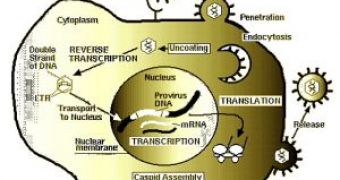The plague of our times, AIDS, is a disease reluctant to cede to the human efforts looking for a cure. "There are about 30 well-established mutations that can make HIV resistant to one of the 20 drugs used to treat this infection," said Feng Gao at the Duke Human Vaccine Institute in Durham, North Carolina, US.
Now, a new, 1000 times more sensitive test that detects tiny levels of drug-resistant HIV in the blood has been developed. This test could help patients to avoid medicines that would be inefficient from the start, and would further debilitate uselessly the infection-fighting organism.
When drug-resistant HIV succeeds, it can multiply freely and subsequently weaken the immune system, rendering the organism more prone to developing AIDS. Current tests detect drug resistant strains when they have already reached about 20% of the viral load, but, "By this point the resistant strain has gained a dangerous foothold in the body", said Gao.
An earlier identification would help doctors to figure a proper medication. The team developed fluorescent tags that match some of the 30 resistance-related mutations. The tags and the virus extracted from the blood of HIV patients are placed in an acrylamide gel in a machine.
The tags stuck to matching resistant viral sequences that glow green and can be counted. If the test reveals a mutation at a certain known position, doctors would forbid a certain drug linked to be inefficient for that mutation. "The new test can detect a single mutated virus among 10,000 non-mutated viruses from a patient sample", said Gao. The test is proven to have an error rate of only one in every million virus particles analyzed. "The stakes are high when a physician has to choose therapy for a patient with a drug-resistant virus," said Richard Shafer of the HIV Drug Resistance Database at Stanford University in California, US.
"The correct combination of drugs can halt virus replication and disease progression in its tracks. An incorrect combination of drugs not only enables the virus to continue to replicate but also makes a patient's virus resistant to even more drugs."
10-20% of HIV-infected patients in the US and Europe carry drug-resistant strains and their percentage is increasing. Early detection would decrease the amount of these strains inside the population. However, "There are major challenges that this and other methods must overcome before being widely adopted", said Shafer. "Many of the deadly minor drug-resistant viruses are not in plasma but reside instead in a semi-latent form in cells, which are not present at large numbers in blood samples".

 14 DAY TRIAL //
14 DAY TRIAL //